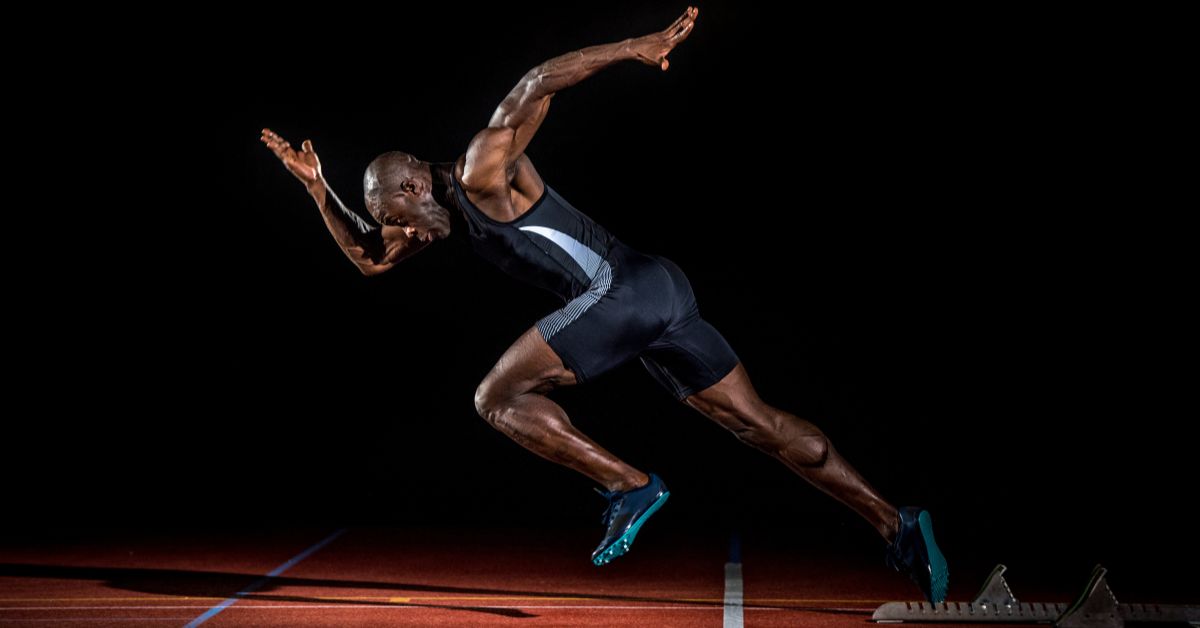
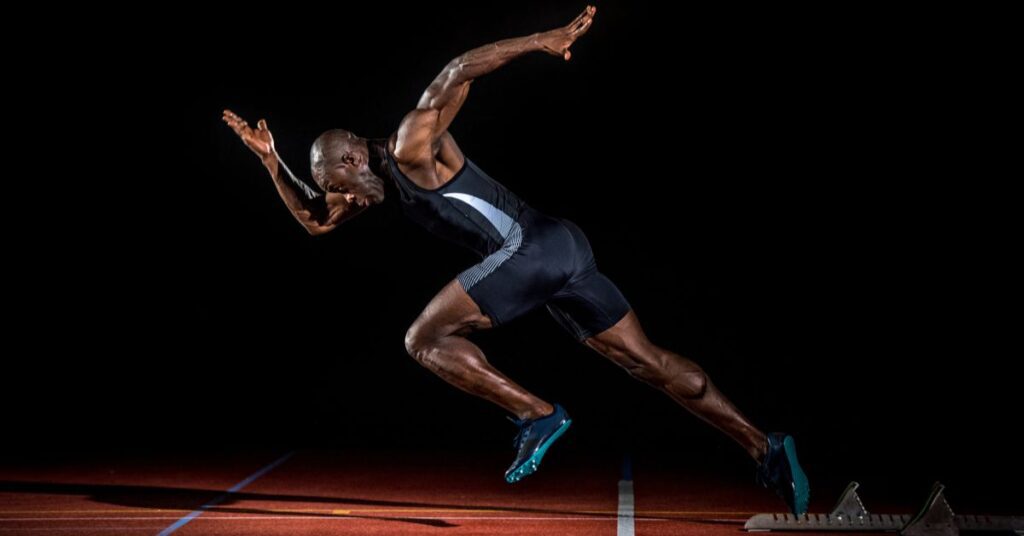
An efficient begin and preliminary acceleration can set the desk for the remainder of the run. Optimizing power software, the switching of limbs, and maximizing momentum early on can enable a seamless transition to max velocity (prime pace) and an optimum stability between stride size and stride frequency.
Enhancing expertise in these areas when utilizing a standing begin can present priceless stepping stones to success with different beginning positions: i.e., three-point, four-point with out beginning blocks, and four-point with blocks.
Warning
I do know it might be tempting for athletes to wish to check out new issues which are discovered, but when they’re not in enough situation, intense sprinting may end up in damage. There are various nice applications on the market that function quite a lot of workouts and strategies to arrange the physique for the trials of sprinting, and it goes with out saying that paying enough consideration to correct warm-ups, stretching, and cooling down is significant. After the following part, nonetheless, the main target of this weblog submit can be on approach.
A Phrase About Bodily Improvement and Power Coaching
In our society, we will get away with not having to do very a lot bodily labor and train. Distinction this with our ancestors, whose survival included a necessity to carry out handbook labor, strolling, and many others.—this clearly offered our forefathers with a greater health base than we usually have immediately. I prefer to preserve this in thoughts after I advise and prepare athletes in power coaching. My ideas go towards contributing to their common health base and letting it profit sprinting as it’s going to.
Having mentioned that, I additionally consider it’s priceless to concentrate on the muscle groups which are extra immediately associated to sprinting success and provides them the eye they’re due. Admittedly, since I coach center faculty and highschool athletes, power work is addressed primarily with body weight workouts, drugs balls, lifting tires, and doing hills in varied methods.
Lastly, studying to recruit the glutes successfully is universally understood as a key side. This glute recruitment video is price , because it references exterior and inside pelvic rotation and the massive toe being involved with the bottom—points that relate to varied workouts utilized in coaching, in addition to to sprinting. As well as, the e book Working by Frans Bosch and Ronald Klomp additionally particulars how the glutes work with the quads, hamstrings, and calf muscle groups by way of every stage of the dash.
Studying and Educating
This weblog article is directed towards coaches, in addition to athletes who’re mature sufficient to obtain instruction on approach and successfully apply it. The ways in which athletes obtain data and apply it could differ. Coaches and athletes want to comprehend this.
Stu McMillan made an awesome statement of the kinds of cues his athletes benefited from. He mentioned, “Athletes typically match into two classes, ones that may really feel the foot on the bottom rather well, versus those that really feel the limbs in house rather well.” So, for upright working, some could reply higher to cues just like “pushing down into the bottom,” whereas others relate higher to “driving the thigh into house or their hand up into house.” So the cue, “drive the hand up up up up, and that will convey your entire system up,” may fit for some athletes, whereas “really feel the foot go straight down, straight down, step down, get better up, straight down,” may fit higher for others.
Athletes trying to focus on cues they aren’t good at receiving can disrupt their rhythm and timing. In short, it’s important to choose words carefully, says @TheYouthTrainer. Click To Tweet
There are additionally athletes who, at prime pace, really feel their ft on the bottom and others who don’t. Rhythm and timing are necessary components of sprinting, and athletes making an attempt to deal with cues they aren’t good at receiving can disrupt their rhythm and timing. In brief, it’s necessary to decide on phrases rigorously—ALTIS coaches even speak about how “temper phrases can considerably improve outcomes for coaches and athletes alike.”
Energy Perceived
The next quote is from a course I took with ALTIS, and speaks to a lot of what I’ve mentioned thus far and what I’ll be saying afterward: “Because it pertains to our key phrases as an environment friendly retrieval of a technical idea, energy is necessary solely throughout early acceleration—when time on the bottom is in extra of time within the air. As soon as flight time exceeds floor contact time (in most elite sprinters, someplace across the sixth to ninth step), the phrase ‘energy’ is not efficient, and we should always transfer on to phrases that extra precisely describe our technical goal for the rest of the run. Nonetheless, as a result of the pace reached within the preliminary steps extremely correlates with the pace reached at most velocity, it’s important that the athlete maximize this portion of the run. Energy is a phrase that resonates with most athletes, and once they have the time required to really feel a horizontal push throughout preliminary acceleration, energy is most helpful in reminding the athlete of the particular goal and really feel.”
I additionally assume one thing simply relatable to athletes is Jonas Dodoo’s assertion describing the part of the race the place the sensation of energy is extra prevalent: “A lot of the effort is on the finish of the push.” Nonetheless, as described earlier, some athletes could also be extra conscious of the pump of the knees throughout this time.
The Begin Outlined
In his e book, The Mechanics of Sprinting and Hurdling, Ralph Mann mentioned the beginning consists of three steps. Within the context of utilizing beginning blocks, he refers back to the begin as “Block Clearance,” “Step One,” and “Step Two.”
I prefer to discuss with the beginning as a part of “Getting Out,” with the understanding {that a} sufficiently big power and sufficiently big actions can be used and directed up the monitor (defined later).
Beginning Development
Since I consider that the performances and expertise demonstrated out of a standing begin might be checked out as a prerequisite to success with different beginning positions, in addition to having carry-over worth, I get fairly detailed in my method. I consider standing begin apply has specific worth when carrying coaching footwear or racing flats on a floor that provides an affordable diploma of traction. Clearly, moist grass and sand on a monitor usually are not good selections.
With a standing begin and with out spikes, the athlete should use a excessive degree of ability to grasp physique positioning, balancing methods, power software, and instructions of power to have the ability to begin explosively and successfully transfer up the monitor. “Successfully transferring up the monitor” contains success in coping with the touchdown forces related with the standing begin, which, for my part, received’t be as nice as these encountered from aggressive three- and four-point begins and people with beginning blocks. In my thoughts, this constitutes a step within the means of creating eccentric power, in addition to enhancing coordination, timing, stability, and many others.
A basic ingredient of sprinting is establishing and sustaining a big break up on the knees throughout acceleration, as you possibly can see on this Carmelita Jeter video. Addressing hip mobility and power helps this. The massive break up can also be a necessary a part of the “knee elevate motor sample,” which is critical to supply the highly effective vertical power into the monitor, a key to max velocity (defined later). As soon as once more, standing begins present the final word particular “lead-up” exercise.
Ideally, on the finish of the day, this development will result in how world-renowned dash coach John Smith described the beginning and preliminary portion of a dash: “It isn’t about thrust as a lot as it’s about stability—about every step being so completely positioned that it units the stage for optimizing the ability of the following step.”
Standing Begin Fundamentals
Whereas positioning the physique to get out to a very good begin, you will need to assume a beginning stance at an acceptable place in relation to the beginning line. Novices usually assume a place the place their heart of mass is an excessive amount of to the rear of the beginning line.
For the “set” place within the standing begin, there must be a hip hinge motion sooner or later, the place the torso goes ahead, the hips transfer again some, and the again is straight. Ideally, bending skillfully and being poised to start out explosively embrace getting ready the glutes to be recruited in anticipation of taking the physique ahead and upward throughout the beginning motion.
Ideally, bending skillfully and being poised to start explosively includes preparing the glutes to be recruited in anticipation of taking the body forward and upward during the starting action. Click To Tweet
The pinnacle must be forward of the beginning line, and the shoulders ought to no less than be as much as the road however in all probability forward of the road to some extent. The hips ought to really feel shut sufficient to the road, with the ft aligned with the knees and hips. The knee and shin of the ahead leg within the beginning stance ought to really feel shut sufficient to the road, with the physique bent to a point whereas anticipating the push-off. About two-thirds of the burden is centered over the place of the entrance leg within the beginning stance.
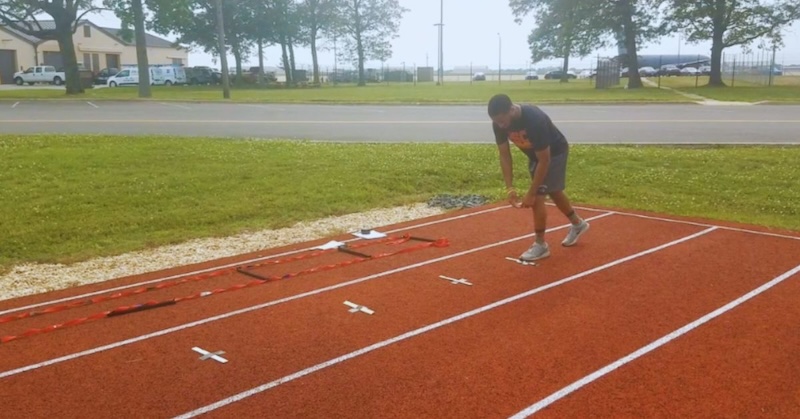
FYI—I don’t just like the standing begin technique of “get up straight with little or no bend on the knees, lean ahead, then collapse on the joints” in response to the beginning command. This won’t function an efficient lead-up to different begins, as making an attempt to simulate this with three- and four-point begins can—as Dan Pfaff factors out—end in projection angles which are too low and stability points that athletes attempt to right with zigzag working.
There’s a quote associated to standing begins from the article “What’s the Drive Part in Sprinting, Half 3” that will even be useful: “You possibly can’t push out of your toes as toes are supposed to grip. The gripping toes create stability for the push off. That is the important thing to power software and push mechanics when ranging from a standstill (traction).”
Gentle Standing Begins
To reduce the wear and tear and tear on the legs throughout warm-up runs and plenty of coaching runs, I usually enable athletes to do “smooth begins.” This implies the athletes are allowed to maneuver to the road and roll, skip, and in any other case transfer into the begins as they need. Requiring the athletes to be utterly stationary earlier than beginning might be fairly irritating for the legs. Stu McMillan of ALTIS additionally explains and reveals athletes transferring into begins on this video.
Decelerate Correctly
When working any distance, you will need to take note of the way to decelerate. If the athlete merely turns off their focus and lets gravity gradual the physique down after crossing the end line, accidents can happen—i.e., hamstring accidents. This video does an awesome job of explaining this.
Overcoming Inertia
Inertia is a top quality that lets one thing keep nonetheless whether it is nonetheless or retains it transferring whether it is transferring. Within the context of a race, the starter/official needs the athletes to be nonetheless when within the “Set” place in order to not acquire an unfair benefit, however as you see fairly often, sprinters get away with refined actions earlier than the gun.
Overcoming inertia requires making use of a power, however in a race, it’s also necessary to have the ability to apply the power shortly to get out with or forward of the competitors. So, one of many challenges in beginning is to provide you with a technique to be prepared each to react shortly and start transferring powerfully up the monitor.
There are quite a few methods to be efficient, associated to being coiled and able to uncoil like a spring, together with the athlete specializing in how the physique or physique half will transfer in response to the gun slightly than specializing in the starter’s gun. It’s no completely different when utilizing a standing begin, though sure particulars can be particular to that individual beginning place.
Shin Angles
When within the standing begin place, usually, the shin of the entrance leg isn’t angled ahead in any noticeable method. Throughout the beginning motion after being required to be stationary, nonetheless, there’s a refined motion of the entrance foot off its spot, and a ahead shin angle happens because the entrance leg joins the rear leg for the push-off because the physique strikes ahead. Observe that on this video under (that is additionally clearly evident in soccer large receivers).
For 3- and four-point begins, the place the motion of the entrance foot off of the spot doesn’t happen, and the entrance shin is already at a ahead angle when within the “Set” place, 45 levels to the bottom is recommended; that is carefully associated to the departure trajectory.
In my thoughts, an athlete, recognizing these variations, can improve physique consciousness, coordination, and timing by studying the way to obtain an optimum degree of energy for the push-off for every beginning place.
Though the shin is angled on the meant departure trajectory for three- and four-point begins, there may be no less than just a little discount within the angle between the shin and the bottom throughout the push-off. That is evident on this slow-motion begin video; nonetheless, a sprinter with good leg stiffness qualities shouldn’t exhibit a lot of a discount in shin angle throughout three- and four-point begins. The slow-motion begin video options former world document holder Asafa Powell. He clearly has good leg stiffness, and you’ll see that his shin angle doesn’t cut back very a lot.
Extra on Standing Begin Footwork
A foot motion that’s not acceptable is one by which the rear foot steps backward to provoke the push-off. I consider that is usually carried out when the ft usually are not sufficiently unfold initially, but in addition if the athlete simply isn’t conscious of what I described above or isn’t capable of successfully pull it off. Regardless, I really feel that this negatively impacts hip top, amongst different issues.
A foot movement that is not acceptable is one in which the rear foot steps backward to initiate the push-off, says @TheYouthTrainer. Click To Tweet
When athletes doing a standing begin are allowed to roll or fall into the beginning, the refined motion of the entrance foot off the spot usually received’t happen for the reason that rolling ahead creates the ahead shin angle. Observe this when watching this athlete subtly roll into his begin.
Three-Level and 4-Level Begins
In order that this weblog article isn’t overly lengthy, I received’t give step-by-step particulars about three-point and four-point begins, however I’ll first level to some very important concerns after which to particular areas the place standing begin expertise can carry over.
Very important Concerns
When utilizing blocks, having enough spacing for the positions of the pedals, in addition to permitting a part of every foot to be on the monitor, are necessary points benefiting from the training development I’m describing. Some high-level athletes might be able to be efficient with their ft off the monitor and up on the block pedals, however this isn’t urged for many athletes.
The urged spacing for beginning blocks—two footwear from the road for the entrance block and three footwear from the road for the again block—is simply too removed from the beginning line for four-point begins with out blocks. Conversely, many excessive schoolers who usually are not allowed to make use of blocks throughout prelims in a monitor meet, however do have good spacing for the ft with out blocks, attempt to use the identical foot placements when they’re allowed to make use of blocks throughout the finals. The result’s a place that’s too near the road and cramped.
The underside line is that when doing standing begins, it’s fairly simple to determine the way to be positioned on the line, together with how to house the ft, in order that impediment is definitely negotiated, and the main target might be on enhancing physique positioning, stability, and many others. Nonetheless, when making an attempt to do three- and four-point begins, if the ft usually are not in a very good place, the beginning won’t ever be an awesome one, and a variety of apply can be in useless. One other necessary beginning block primary ingredient is described in #3 under.
Six Areas The place Standing Begin Excellence Can Carry Over
- Being in the proper place in relation to the beginning line.
- Correctly centering weight over the place of the entrance leg.
- An athlete capable of place, stability, and explode out of a standing begin place ought to give you the chance to take action from a three- and four-point stance with out it being a pressure on the palms and arms. Usually, the athlete might want to learn to skillfully rise from the “On Your Marks” place, letting the hips go up and again some at an angle in order that an excessive amount of weight received’t be on the palms. Having mentioned this, the athlete must be cautious to not have the hips transfer backward in such a method as to have the momentum going backward when prepared to answer the gun.
- A serious intention is to have the ability to aggressively and powerfully undertaking up the monitor right into a excessive submit with step one, as seen within the photograph under. There must be a punching-type knee motion, with the primary stride being accomplished by dropping/pulling the leg again down aggressively because the physique strikes ahead and the trailing leg known as into motion quickly and as linearly as potential. Once more, pulling this off from the standing begin place offers an awesome stepping stone towards the longer term.
- With nice beginning ability, a purpose must be, as Maurice Greene mentioned, to “use as a lot energy as potential, however use as little vitality as potential.”
- Seamless transition to max velocity, with an awesome stability of stride size and stride frequency
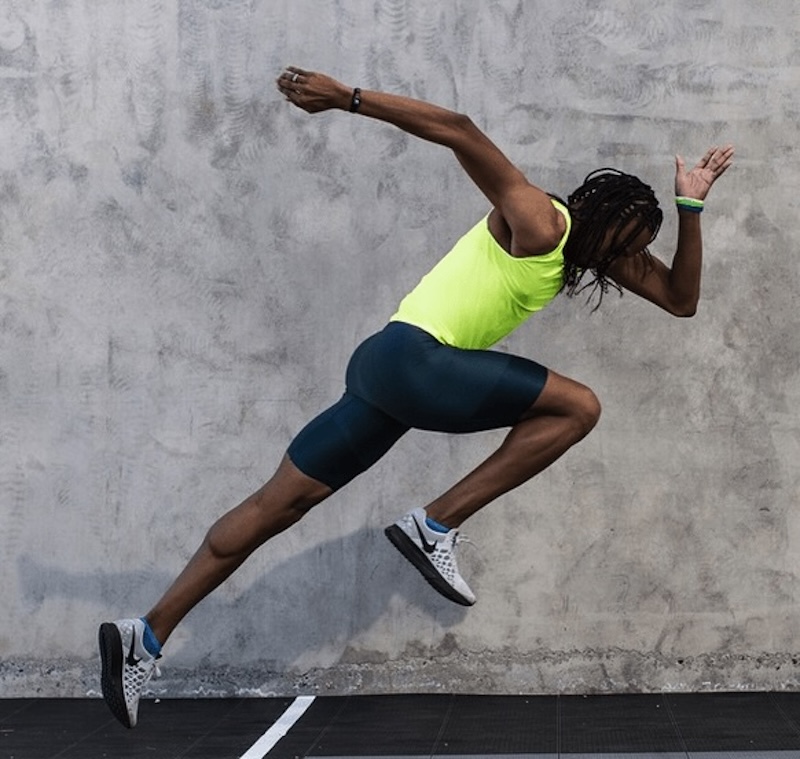
(Photograph Courtesy of ALTIS)
Vital Arm Motion Element of the Three- and 4-Level Begins
To correctly contain the arms throughout the begin, as a substitute of simply choosing the hand(s) off the monitor, the arms ought to make a sweeping movement by way of a very good vary of movement, with the hand reverse the entrance leg sweeping again and up. That is demonstrated at in regards to the 2-minute 20-second mark of this video, that includes Olympic gold medalist Justin Gatlin and Coach Brooks Johnson.
For 3-point begins, the identical goes for the motion of the hand that’s on the bottom; the one distinction is that the hand going ahead comes from a distinct place.
If the arms don’t transfer correctly in coordination with the legs, the push could also be shortened or untimely. Arm motion must proceed to be in sync with the legs and common working actions to maximise efficiency.
Significance of Max Velocity
Though the beginning and preliminary acceleration are necessary, the essential side for sprinters to develop is max velocity (prime pace). What we lined beforehand helps put the athlete able to maximise max velocity, and every element defined under relates strongly to max velocity growth.
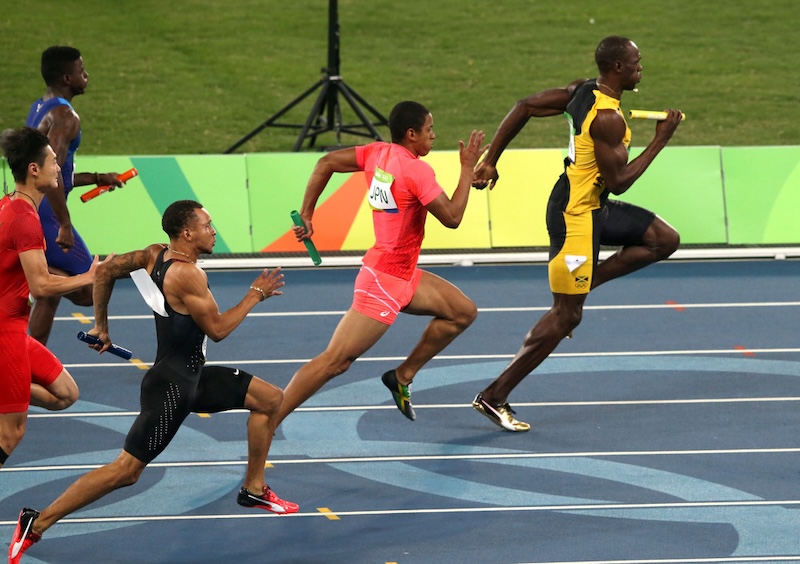
(Photograph by Daniel A. Anderson/ZUMA Wire/Icon Sportswire)
Linear and Rotational Elements of Sprinting
Though there are positively linear points to sprinting—i.e., the athlete is making an attempt to journey a straight line up the monitor from level A to level B—and aspect sway working actions are inefficient, you will need to perceive that working options rotational actions that counterbalance each other. Dan Pfaff explains on this video how the hips and shoulders coordinate on this method. Once more, referring to the athletes, how they really feel the rotation is essential and a necessary a part of their capacity to proceed to successfully apply power because the ft spend much less and fewer time on the bottom.
Go to the 27-minute and 40-second level of this video for a pleasant description by Jonas Dodoo about power software throughout upright sprinting at excessive speeds. When you will have time, I recommend trying out the entire video.
Understanding the Results of Horizontal and Vertical Floor Forces
Sprinting is a mixture of horizontal and vertical floor forces. Mann states, “The quantity of Vertical power produced throughout the Block portion of the beginning, in addition to the following two steps, is definitely nearly the identical because the Horizontal power.” This will sound shocking to many coaches who equate vertical power with “popping up.”
It is very important remember that the target is to direct the mixed forces at an excellent trajectory. Typically, it takes watching movie to see how shut an athlete got here to the urged “Excessive Submit” place with step one, once more, proven within the picture from ALTIS above.
Important First 10 Meters
After the primary three steps, Mann states, “The Mechanics of the Dash start a transition from a robust Horizontally directed drive to a extra Vertically directed effort seen within the Most Velocity Dash Mechanics.” This isn’t, nonetheless, to reduce the significance of horizontal forces. Alluding to the primary 10 meters, Mann states that is the place “the manufacturing of Horizontal floor power is of vital significance.”
Though this could have the impact of getting the athlete transfer by way of house in a comparatively low-to-the-ground, leaning-forward posture, it’s a mistake to inform the athlete to attempt to keep low.
The hips and torso ought to rise collectively, and there are completely different cues to assist the athlete rise appropriately. Dan Pfaff likes to say “hips climbing” and a few could say “rise by way of the hips” since one impact is that the legs will exhibit much less bend on the knees because the hips rise. Two of John Smith’s drive part cues that I acquired from a few of his supplies are “simulate working downhill” and “Preserve arms in entrance (attain out—don’t overdo it although).”
After the First 10 Meters Via Most Velocity
Because the athlete continues to speed up, and as soon as once more, with vertical forces changing into increasingly more major, there’ll come a time to transition into what I prefer to discuss with as a “pelvic repositioning” and the “prime pace gear.” Within the e book Working, Bosch and Klomp describe this by stating, “In the intervening time when velocity is almost most, the trunk is then directed extra upright whereas the pelvis is pushed farther ahead.” Once more, I additionally refer you again to the “knee elevate motor sample” as being important for highly effective vertical power manufacturing.
Mann provides, “The utmost velocity that the athlete can produce relies upon how lengthy productive Horizontal forces might be utilized. As soon as Most Velocity is reached, the purpose have to be to supply the massive degree of Vertical power required to take care of correct Mechanics whereas persevering with to supply the small quantity of optimistic Horizontal power wanted to take care of Most Velocity.”
In different phrases, there’s a bounciness that has the athlete transferring ahead at prime pace. Throughout the bounciness, the ft are pushing up, not lifting the top and chest. Describing the posture, Lorenes Seagrav likes to say, “tummy tight, again flat, hips dealing with up (butt tucked).” John Smith likes the cue “chin down.” I additionally just like the cue of “imagining that there’s a string from the sky hooked up to the highest of the top, pulling upward.”
Vital Max Velocity Technical Elements
When transitioning into the highest pace gear, B skip drill dynamics turn out to be extra of part of the strides. This superior video explains vital do’s and don’ts for the strides throughout this part. The entire video is nice, however you possibly can ahead to the 27-minute, 30-second mark for what I’m particularly referencing.
I additionally like Usain Bolt’s max velocity cues, “shoulders down and knees up, swinging from the hips.”
Utilized to the 40-Yard Sprint
Not like a 100-meter sprint, for the 40-yard sprint, it’s potential to speed up from the beginning line throughout the end line with none deceleration. In reality, the acceleration phases are abbreviated to attempt to arrive at prime pace extra shortly and take that prime pace to the end line. Which means that the rhythm of working a 40-yard sprint must be just a little faster than the rhythm of working a 100-meter sprint.
Unlike a 100-meter dash, for the 40-yard dash, it is possible to accelerate from the starting line all the way through the finish line without any deceleration, says @TheYouthTrainer. Click To Tweet
The Standing Begin Is a Talent
Though I don’t consider it essential for the athlete to really feel that they’ve perfected the standing begin earlier than transferring on to different positions, I do really feel it useful that the athlete acknowledges makes an attempt to be skillful with the standing begin may give them a deeper understanding of the way to make the most of the early parts of the race to maximise efficiency.
Because you’re right here…
…we now have a small favor to ask. Extra persons are studying SimpliFaster than ever, and every week we convey you compelling content material from coaches, sport scientists, and physiotherapists who’re dedicated to constructing higher athletes. Please take a second to share the articles on social media, have interaction the authors with questions and feedback under, and hyperlink to articles when acceptable when you’ve got a weblog or take part on boards of associated matters. — SF
